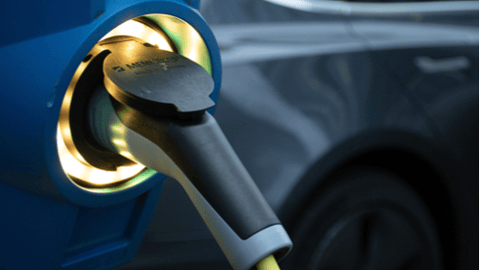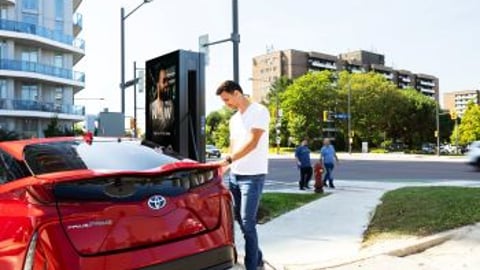Liberals rev up $2B plan to shield auto sector from U.S. tariffs
On the same day that Liberal Leader Mark Carney unveiled his plan to protect the domestic auto industry, U.S. President Donald Trump announced a sweeping 25% tariff on all cars not made in the United States.
“What we’re going to be doing is a 25% tariff for all cars that are not made in the United States,” Trump said in the Oval Office. “We start off with a 2.5% base, which is what we’re at, and go to 25%.”
Trump said the new tariffs are set to take effect on April 2 and collection begins the following day. “If you build your car in the United States, there is no tariff,” Trump said.
Speaking earlier in the day, Carney had announced the Liberals will create a $2 billion fund to build an “all-in-Canada” auto supply chain.
“Without the auto sector, nothing can be built; without a strong workforce, the auto sector could not exist, and without strong unions, there would be no workers,” said Carney in a statement. “With today’s announcement, we will protect workers from U.S. tariffs, create better-paying jobs, and build a 100% Canadian auto manufacturing network.”
The proposed Strategic Response Fund would support Canadian suppliers, reduce reliance on cross-border parts and expand use of Canadian steel, aluminum and critical minerals, especially for electric vehicle (EV) battery production, Carney said.
Auto parts currently cross the U.S.-Canada border up to six times before final assembly, he added. “In a trade crisis, that’s a vulnerability,” he warned. “It’s time to build more cars right here at home with an all-in-Canada auto manufacturing network.”
That vulnerability has been put on display with Trump’s new tariff.
"China could only dream of damaging the American auto industry so quickly and so decisively as what Trump is threatening to do here again," said Flavio Volpe, president of the Automotive Parts Manufacturers’ Association.
He added that risking the livelihoods of hundreds of thousands of auto workers for political purposes was both unexpected and deeply concerning, and described the tariff as confusing and lacking a factual basis.
READ: Trump places 25% tariff on imported autos, expecting to raise $100 billion in tax revenues
Ontario voters on the line
Carney’s $2 billion announcement also included a stipulation that federal procurement would be directed toward Canadian-built vehicles to stimulate local industry.
Ontario is home to factories for industry giants like Ford, GM, Stellantis, Toyota, and Honda, which collectively produced 1.54 million cars, pickups and SUVs last year.
Carney’s plan will come as welcome news in vote-rich Ontario where as many as 500,000 jobs depend on the industry’s stability, said Sheldon Williamson, professor at Ontario Tech University, and Canada Research Chair in Electric Energy Storage Systems.
“Policies that protect and grow the sector resonate strongly with voters, particularly in swing ridings,” Williamson said. “Any party looking to form a government needs to demonstrate a credible plan to support these workers and businesses, making auto policy a central election issue.”
However, Canada is challenged by the high degree of integration our industry has with U.S. vehicle manufacturers, said Peter Graefe, political science professor at McMaster University. At the moment, Canadian parts are used by U.S. automakers doing the assembly.
“Given the size of the automotive sector, $2 billion is not a whole lot of money,” Graefe said.
The federal government is signaling a willingness to support more autonomous domestic production, but without a Canadian-owned final assembler, that autonomy has limits, he added.
Nonetheless, announcements like this carry political weight, as they allow the Liberals to demonstrate concern and action — key factors in projecting economic credibility in Southern Ontario, even if the plan itself lacks innovation or sufficient scale, Graefe said.
Carney’s announcement was cheered by the EV sector, which has been putting down roots in Ontario backed by a $100 billion federal government strategy to build an industrial ecosystem in the province but has suffered a series of setbacks.
“It’s encouraging to see an emphasis on supporting the next generation of the Canadian auto sector. The global industry is migrating towards zero emission vehicles and Canada has the capacity to build an entire supply chain to meet that evolution,” Matthew Fortier, CEO of Accelerate ZEV, an industrial advocacy body, told Canada’s National Observer.
“This sector has been arguing for a made-in-Canada approach to encourage the use of domestic resources, materials, components and labour. This will set us up to make what the world will want and need in the future, which is a pretty good tariff protection strategy.”
Japanese automaker Honda and Volkswagen-owned battery maker PowerCo — two EV giants and key players in Canada’s EV ecosystem strategy — declined to comment on the Liberal Party announcement.
A Honda spokesperson told Canada’s National Observer that it remains focused on protecting its 4,000-plus employees in Ontario and wider business operations in the country.
Bea Bruske, president of the Canadian Labour Congress, the country’s largest labour organization, which represents more than three million workers, applauded the Liberal announcement, saying it points to “what’s been missing from the debate until now — an actual plan to build Canada’s industrial and manufacturing capacity.”
She added that the focus on the auto supply chain is “overdue but necessary” as the impact of U.S. tariffs is damaging other sectors connected to auto manufacturing, from raw materials through to car dealerships.
Tariff wall
In response to Carney's announcement in a series of posts on his X account, Volpe of the manufacturers’ association said that Canada’s auto sector has operated for decades under a tariff-free market access model — a framework that has served both countries well but may now be at risk.
If a tariff wall is introduced with the intent of permanently damaging Canada’s industry, he argued, it would be prudent to strengthen the domestic supply chain so Canadian suppliers are better positioned to win contracts with Canadian-based auto assemblers serving the domestic market.
Volpe added that while such a tariff wall would disrupt the value proposition across the industry, Canada still manufactures and purchases up to two million vehicles annually. He emphasized the importance of exploring all options to preserve jobs and ensure a strong return on investment in the sector.
Williamson said Carney’s $2 billion plan is a strategic response to the growing threat of U.S. tariffs. “The focus on an ‘all-in-Canada’ auto parts network and investment in Canadian steel and minerals aligns with the broader push for economic resilience,” Williamson said. “However, the key challenge will be execution — ensuring that these investments translate into cost-competitive and globally attractive manufacturing while navigating potential trade tensions with the U.S.”



